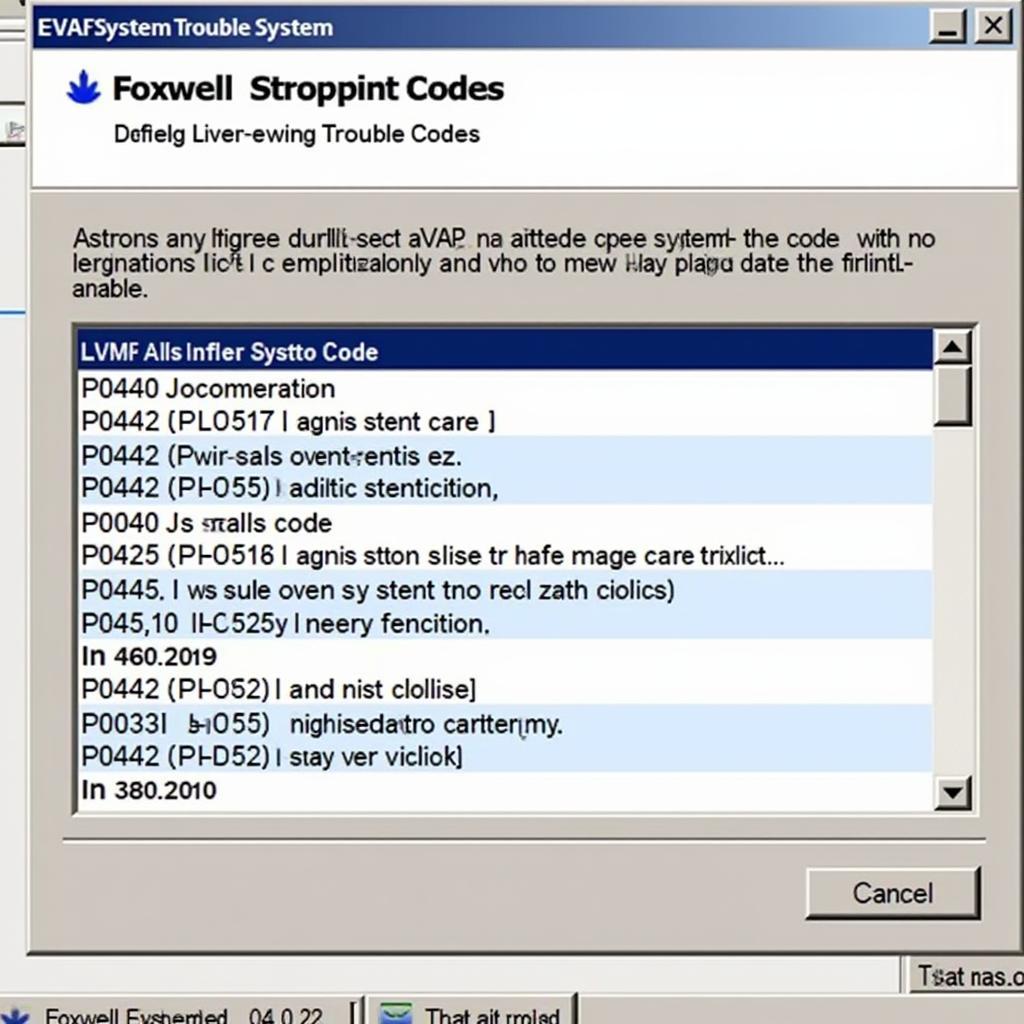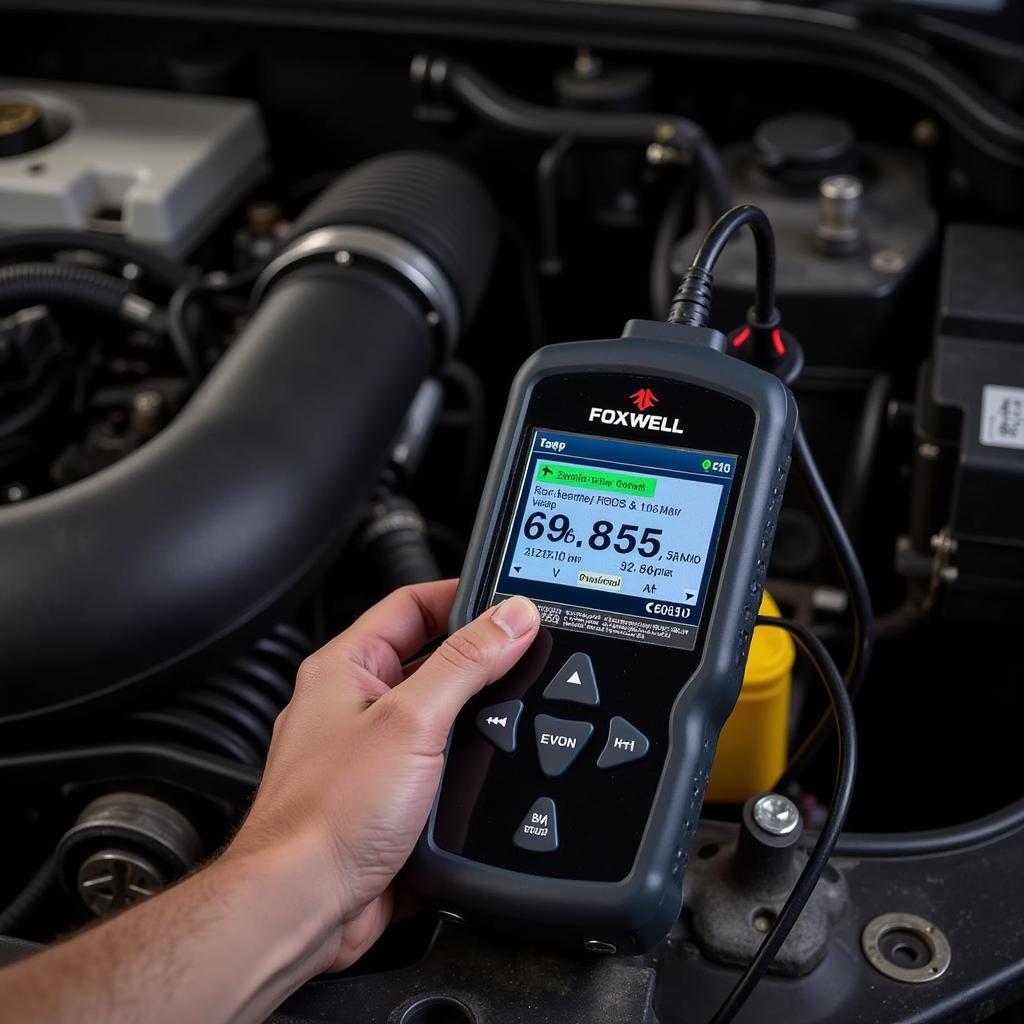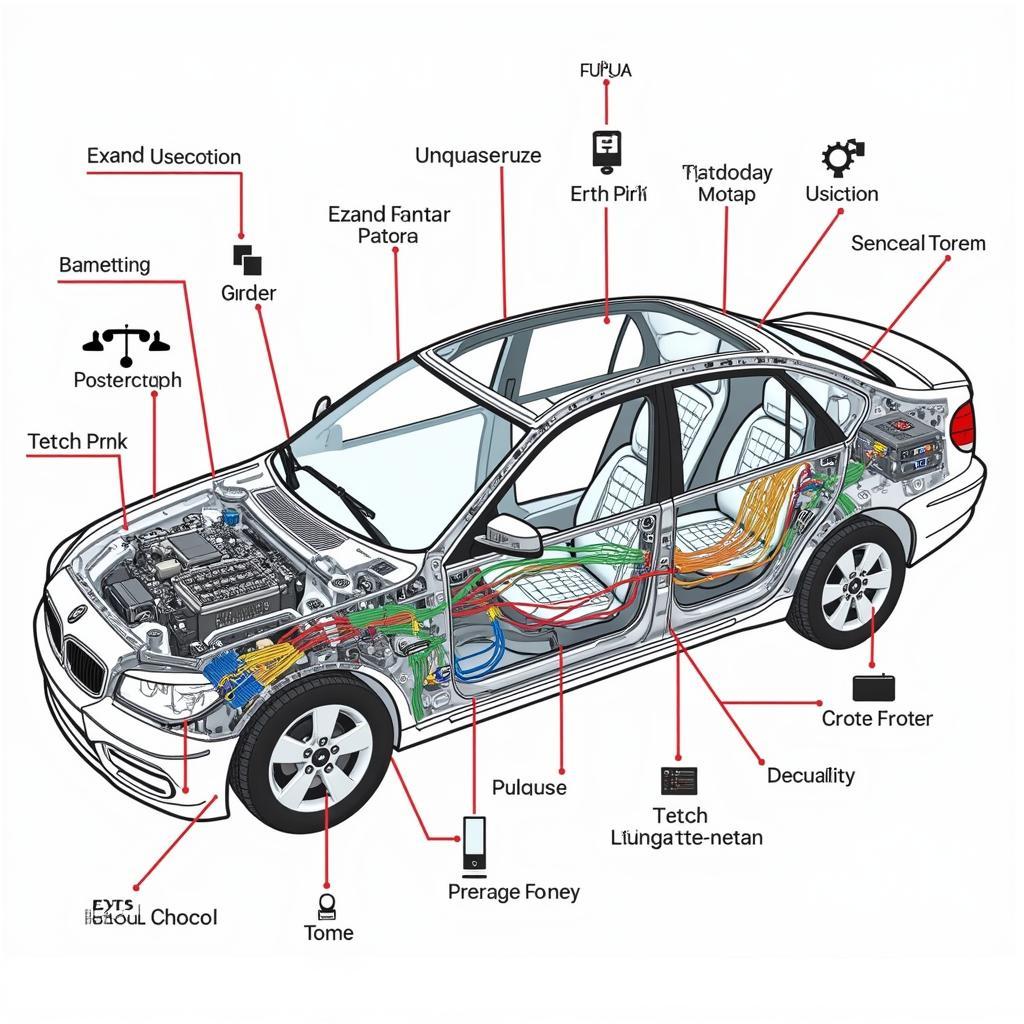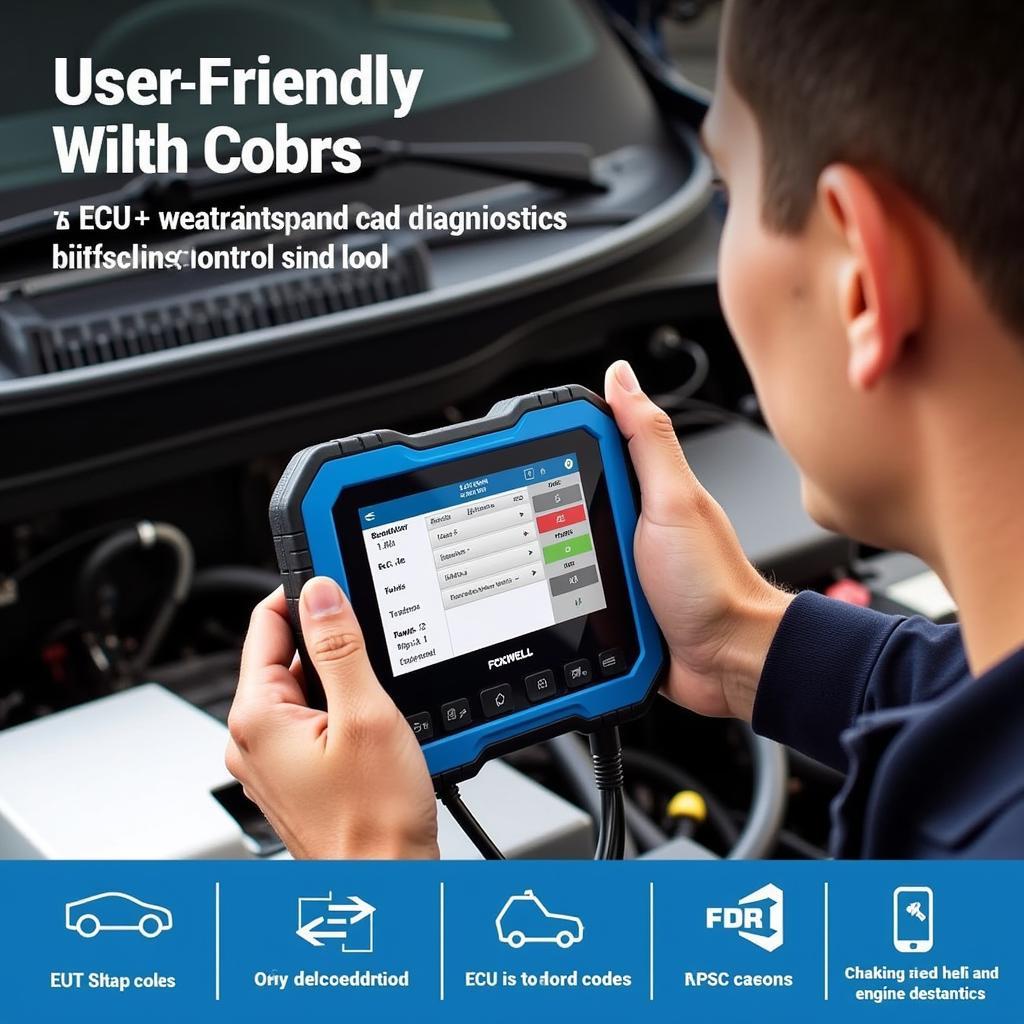The EVAP system is a critical component of your car’s emission control system, responsible for preventing harmful fuel vapors from escaping into the atmosphere. When it malfunctions, you might experience issues like poor fuel economy, a “check engine” light, or even failing an emissions test. That’s where Foxwell Evap Diagnostics come in, offering a comprehensive solution for identifying and resolving EVAP system issues.
This guide will delve into the world of Foxwell EVAP diagnostics, exploring how these tools can save you time, money, and frustration. We’ll cover everything from understanding EVAP systems to choosing the right Foxwell scanner for your needs and performing effective diagnostics.
What is an EVAP System and Why is it Important?
Your car’s engine relies on a delicate balance of air and fuel for optimal performance. The EVAP (Evaporative Emission Control) system plays a crucial role in maintaining this balance while minimizing environmental impact. It does this by capturing fuel vapors from the fuel tank and other components, preventing them from escaping into the atmosphere.
Here’s how it works:
- Fuel Vapor Storage: When your car is parked or not in use, fuel vapors naturally evaporate from the fuel tank. The EVAP system captures these vapors in a charcoal canister, preventing them from polluting the air.
- Vapor Purging: When you drive, the engine control unit (ECU) determines the optimal time to purge the stored vapors. It does this by opening a purge valve, allowing the vapors to flow into the engine’s intake manifold, where they’re burned during combustion.
A properly functioning EVAP system is vital for:
- Reduced Emissions: By capturing and burning fuel vapors, the EVAP system significantly reduces harmful hydrocarbon emissions, contributing to cleaner air.
- Improved Fuel Economy: Burning stored fuel vapors instead of releasing them into the atmosphere means you’re using your fuel more efficiently.
- Preventing Fuel Odor: A malfunctioning EVAP system can lead to a noticeable fuel smell inside or around your car.
Common EVAP System Problems
 Common EVAP System Trouble Codes
Common EVAP System Trouble Codes
A range of issues can affect your EVAP system, often triggering a “check engine” light. Some common culprits include:
- Loose or Damaged Gas Cap: The gas cap seals the fuel tank, preventing vapors from escaping. A loose, damaged, or missing cap is a frequent cause of EVAP leaks.
- Faulty Purge Valve: The purge valve controls the flow of fuel vapors from the canister to the engine. A stuck-open or closed valve can disrupt the system’s operation.
- Cracked or Damaged Hoses: The EVAP system relies on a network of hoses to transport vapors. Over time, these hoses can crack, deteriorate, or become disconnected, leading to leaks.
- Malfunctioning Charcoal Canister: The canister itself can become saturated or damaged, reducing its ability to store vapors effectively.
- Faulty Vent Control Valve: This valve regulates the pressure within the EVAP system. A malfunctioning valve can lead to pressure imbalances and leaks.
Why Choose Foxwell EVAP Diagnostics?
 Foxwell EVAP Diagnostic Scanner in Action
Foxwell EVAP Diagnostic Scanner in Action
While traditional EVAP diagnostics often involve time-consuming visual inspections and pressure tests, Foxwell scanners offer a more advanced and efficient solution. Here’s why they’re a game-changer:
- Comprehensive Coverage: Foxwell scanners, like the popular Foxwell NT201 Scanner, support a wide range of vehicle makes and models, making them suitable for both DIYers and professional mechanics.
- Advanced Diagnostics: Beyond simply reading and clearing trouble codes, Foxwell scanners offer advanced functions like live data streaming, bi-directional control, and component activation, allowing you to pinpoint the root cause of EVAP problems with greater accuracy.
- Smoke Testing Capabilities: Some Foxwell models come equipped with or support optional smoke machines, enabling you to visually detect EVAP leaks by introducing smoke into the system and observing where it escapes.
- User-Friendly Interface: Foxwell scanners feature intuitive menus, clear instructions, and easy-to-understand data displays, making them accessible even if you’re new to automotive diagnostics.
- Cost-Effective Solution: Investing in a Foxwell scanner can save you significant money in the long run by allowing you to diagnose and repair EVAP issues yourself, avoiding costly trips to the mechanic.
How to Perform Foxwell EVAP Diagnostics
Performing EVAP diagnostics with a Foxwell scanner is a straightforward process. Here’s a step-by-step guide:
- Connect the Scanner: Locate your car’s OBD-II port (usually found under the dashboard on the driver’s side) and connect the Foxwell scanner.
- Turn On the Ignition: Turn the ignition to the “on” position but don’t start the engine.
- Access the EVAP System: Navigate to the “Diagnostic” or “OBDII” menu on the scanner and select “EVAP System” or a similar option.
- Read Trouble Codes: The scanner will scan your vehicle’s computer for any stored EVAP-related trouble codes. Note down any codes displayed.
- Clear the Codes (Optional): After noting the codes, you can choose to clear them. However, it’s important to remember the codes for further diagnosis.
- Live Data Streaming: Access the live data stream for the EVAP system. This will display real-time sensor readings, such as fuel tank pressure, purge valve status, and more, helping you identify any irregularities.
- Component Activation: Depending on your Foxwell model, you can activate specific components, like the purge valve, to check for proper operation.
- Smoke Test (If Applicable): If your scanner supports smoke testing, follow the manufacturer’s instructions to connect the smoke machine and introduce smoke into the EVAP system. Carefully observe for any smoke escaping, indicating a leak.
Choosing the Right Foxwell Scanner for EVAP Diagnostics
Foxwell offers a diverse range of scanners with varying features and capabilities. When choosing a scanner for EVAP diagnostics, consider the following factors:
- Vehicle Compatibility: Ensure the scanner you choose supports your car’s make, model, and year.
- EVAP-Specific Functions: Look for scanners that offer advanced EVAP diagnostics, such as live data streaming, component activation, and optional smoke testing capabilities.
- Ease of Use: Choose a scanner with an intuitive interface, clear instructions, and easy-to-understand data displays.
- Budget: Determine your budget and choose a scanner that offers the best value for money without compromising on essential features.
For DIYers or those on a budget, the Foxwell NT201 Auto OBD2 offers a great starting point with comprehensive OBD-II diagnostics, including EVAP system coverage. For more advanced users or professionals, the Foxwell NT510 vs NT650 comparison might be helpful, as these models provide additional features and functionality.
Expert Insight
“Using a Foxwell scanner for EVAP diagnostics is like having X-ray vision for your car’s emissions system,” says John Smith, a certified mechanic with over 20 years of experience. “It allows you to pinpoint leaks and malfunctions that would be nearly impossible to find with traditional methods, saving you time and money in the long run.”
Conclusion
Foxwell EVAP diagnostics provide a powerful and efficient way to diagnose and repair EVAP system issues, ensuring your car runs smoothly while minimizing its environmental impact. By understanding how the system works, choosing the right Foxwell scanner, and following the proper diagnostic procedures, you can take control of your car’s health and avoid costly repairs.
Need help choosing the right Foxwell scanner for your needs or have questions about EVAP diagnostics? Contact the experts at ScanToolUS today. Our team is here to provide personalized guidance and support.
Contact ScanToolUS:
Phone: +1 (641) 206-8880
Office: 1615 S Laramie Ave, Cicero, IL 60804, USA
FAQs
1. What is a Foxwell EVAP smoke test?
A Foxwell EVAP smoke test involves introducing harmless smoke into the EVAP system to visually detect leaks. If smoke escapes from any hoses, connections, or components, it indicates a leak in the system.
2. Can I fix an EVAP leak myself?
Depending on the severity and location of the leak, some EVAP repairs can be DIY-friendly. However, if you’re unsure about any step of the process, it’s always best to consult with a qualified mechanic.
3. How often should I have my EVAP system checked?
It’s a good practice to have your EVAP system inspected annually or as part of your vehicle’s regular maintenance schedule.


